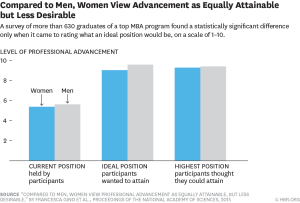Feminine gamification viewpoint: trade offs
This week Harvard Business Review published an article on gender differences in leadership positions, which caught my attention. The authors carried out research, which looked at how women and men decide on whether to go for a higher role or not. One finding based on 630 recent MBA graduates, questioned them where their current position was on a ladder of professional achievement and then how far they felt they could go and also what their ideal role was. The image below shows the outcome of these questions.
The study concluded that women chose ideal roles that were less high on the professional ladder, because they had a perceived time constraint in which they felt they had to achieve all their life goals. The trade offs for taking a higher position were a lot more significant in swaying women to aim lower than they could potentially achieve.
I thought it was interesting to read about the time pressure for life goals and I have to say culture and society probably plays an interesting role yet again. When a women is in her 30’s and single, the regular question in business tends to be when is she getting married or in a relationship, shortly followed by the children question. For some reason people think it is normal to ask a woman these questions, for a man none of this is questioned to the same extent nor would either rule out career progression, whereas working with children is often a big question mark over the ladies’ career. I guess from a natural perspective there is a time frame to being able to have children, so in that regard if it is a life goal, then the pressure is on and usually it comes with the need to have a partner even if technology is far enough to have children without partners.
In my previous work as a business coach, having multiple life goals often lead to stressed out individuals. For my female clients the ranking of goals was always “that depends”, whereas for the male clients it seemed more clear-cut and singular. Maybe again that is how the brain works for either gender respectively. But how we define success and achievement always struck me as being rather different. Saying that I would have classed some women in the same category as men being career seekers and some men in the group of family heroes.
What I typically did though and this is where I used gamification elements to come to decisions, was to monitor behaviour based on actual time spend, then compare it to life goals and have the client decide if they were aligned. Often this was the major wake-up call when they realised either they needed to revise behaviour or in some cases life goals, maybe the things they really wanted they hadn’t been honest about even to themselves, yet their behaviour showed them the obvious truth. In order to break the behavioural habit (if that was their choice), the first step was always habit re-design with small measurable steps to get into a new pattern. Regular reporting and regular feedback to me was built in to the programme with praise or questions depending on the outcome. It was a fun game, when in some cases the family man agreed to have me ring them at 5.30 pm to see if they were on the way home and how some of the true achievers would ring me at 5pm to say I am indeed heading out or the ones that ignored my call because they were working hard still on a ‘major’ project. Either way the truth always came out.
So the question to solve the original gender differences in leadership in my view comes back to is there a business model and structure that allows women to experience all the life goals they want (and men too obviously) if the current structure is clearly not ideal? Secondly we can always play the life goal ranking and behaviour game, to achieve what we want.
What would you suggest to make the balance in leadership more equal?




